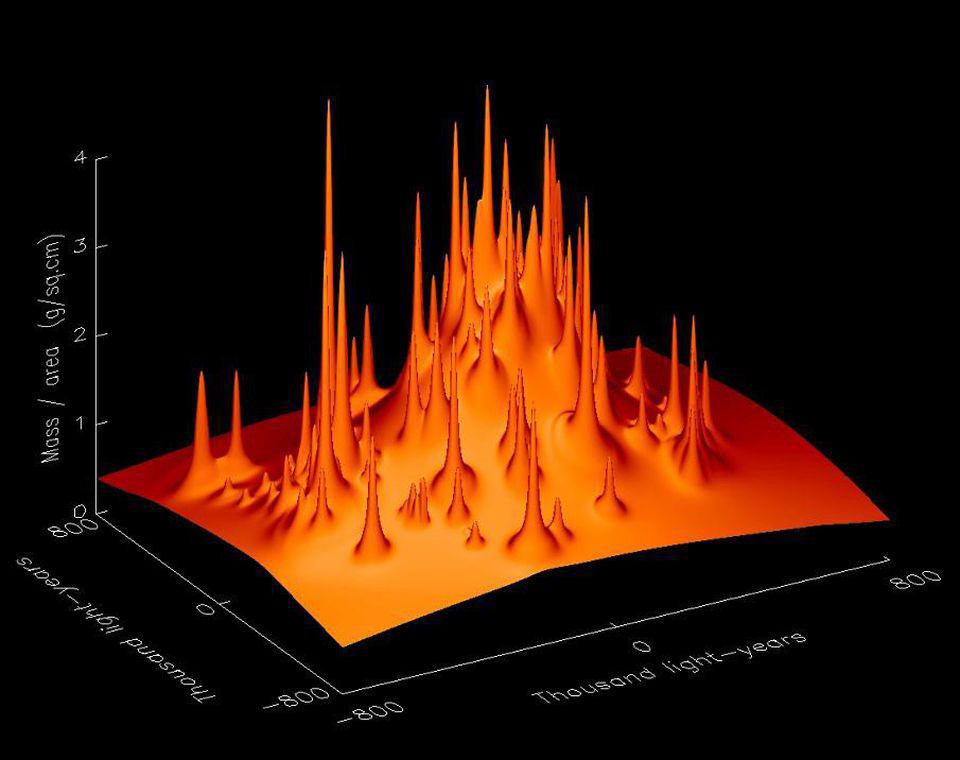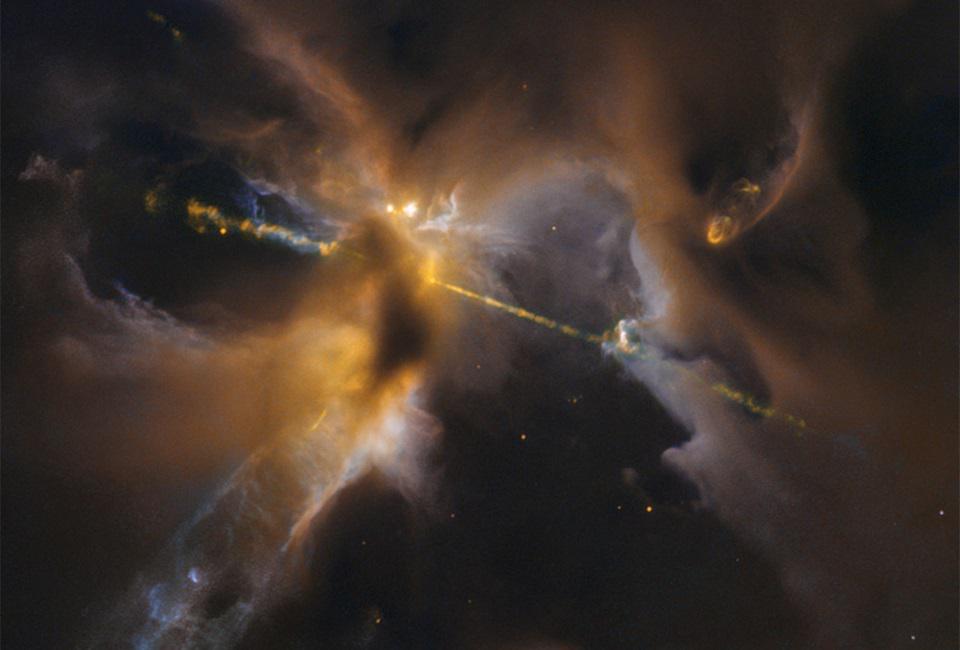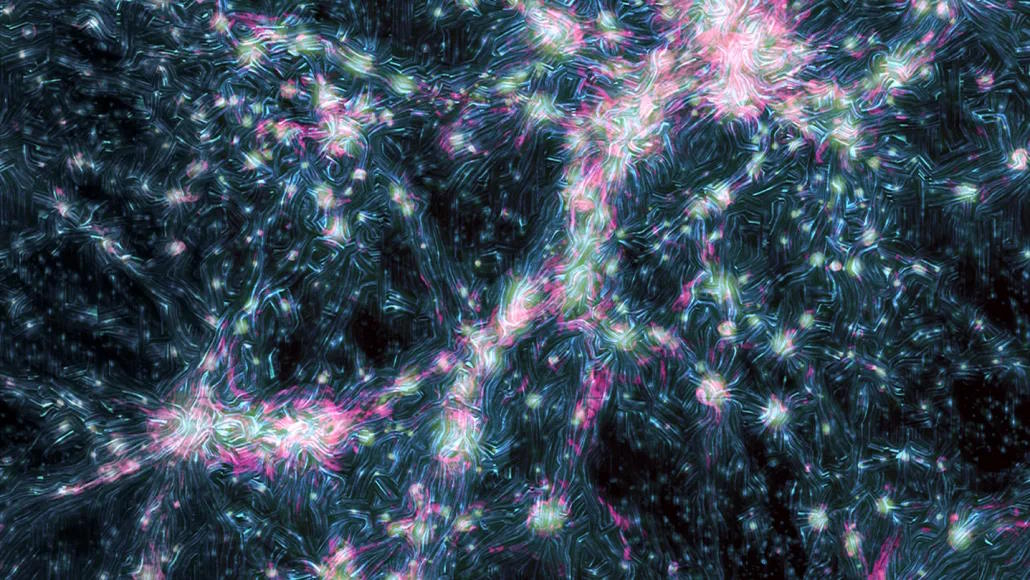Ask Ethan: What would the Universe be like without dark matter?


Here in our own Solar System, it’s normal matter that dominates the massive objects we observe and measure. Humans, planets, moons, and even the Sun are all made up of the same types of ingredients at their core: protons, neutrons, and electrons, bound together into various nuclei, atoms, molecules, and even grander structures. When we observe the orbits of these celestial objects, there’s practically no room for dark matter at all; its presence and its effects on Solar System scales are tiny and negligible. But when we look on larger cosmic scales, including:
- the scales of galaxies,
- at pairs of interacting galaxies,
- at groups and clusters of galaxies,
- at galaxy clusters in collisions,
- and at the large-scale, filament-like structure of the cosmic web,
it’s dark matter that dominates, with normal matter playing an importantly luminous, but gravitationally sub-dominant role.
It’s enough to make one wonder, if dark matter is so important on these large cosmic scales, how would our Universe have been different if it simply weren’t there? That’s what Dave Drews wants to know, writing in to ask:
“How different would the universe be if we didn’t have the effects of dark matter (whatever that turns out to be)? I used ‘the effects of dark matter’ rather than just ‘dark matter’ in case it turns out there is no dark matter, it’s just some property of the universe we don’t currently understand.”
In order to understand how the Universe would be different, we have to first go back to the beginning and understand what role dark matter plays. Only then can we compare that with a scenario where no dark matter is present. Let’s find out!

Back when the hot Big Bang first began, the Universe was filled with every species of particle and antiparticle imaginable. At these very high energies, temperatures, and densities, anything that could be created was created, including every quantum of the Standard Model. Whatever dark matter is, whether a WIMP, an axion, or anything else, was also created very early on. Although the Universe was born almost perfectly uniform in terms of density, there were regions — on all size scales — that were born with either slight overdensities or underdensities, to the tune of about 1-part-in-30,000, on average.
As the Universe expands and cools, many fascinating events happen in cosmic history.
- The electroweak symmetry breaks.
- The Higgs field confers a rest mass onto the known particles.
- Quarks (and antiquarks) bind together into hadrons, including protons and neutrons.
- Antimatter annihilates away, leaving only a tiny excess of normal matter over antimatter (1 protons or neutron for every ~1.6 billion photons).
- Nuclear reactions occur, giving rise to the light elements and their isotopes: hydrogen, deuterium, helium-3, helium-4, and lithium-7, most prominently.
- And then, 380,000 years later, neutral atoms form, as electrons combine with nuclei once the Universe becomes cool enough.
But in between those final two steps — after nucleosynthesis but before the formation of stable, neutral atoms — this “boring” part of cosmic history determined how those initial density fluctuations evolved.

On small cosmic scales compared to the cosmic horizon (or the distance over which light could have traveled since the start of the hot Big Bang), those density fluctuations undergo the following steps.
- Gravity attracts more and more matter into the overdense regions, increasing their density further.
- As the density goes up, radiation streams out of those regions, pushing normal matter (particularly electrons) out with them, but not dark matter.
- This causes the density to drop, which leads to oscillations: growth-and-shrinking of these regions, periodically.
- And as the Universe expands, larger and larger scales begin to infall-and-grow, then outflow-and-shrink, and then oscillate.
- Until finally, when neutral atoms form, there’s a big “peak” in overdensity where the matter is falling in, for the first time, right now, but has never been pushed out.
This process creates a series of peaks-and-valleys in the temperature of the cosmic microwave background; where the peaks are highest, the overdensities are strongest. Millions and even billions of years later, the highest peaks will translate into the greatest mass overdensities, leading to cosmic structures on those scales: star clusters, dwarf galaxies, large galaxies, galaxy groups and clusters, and even, eventually, the grand cosmic web. Those small cosmic seeds, initially so seemingly small and unimportant, will ultimately grow into the structures that the Universe possesses.

Credit: E M Huff, the SDSS-III team and the South Pole Telescope team; graphic by Zosia Rostomian
When those structures form — structures like galaxies, for example — they’ll initially pull matter into them irrespective of what species (normal or dark) that matter is. If dark matter is five times more abundant than normal matter, then in each structure (e.g., each galaxy) that forms, the initial composition will be ~17% normal matter and ~83% dark matter. However, these two species of matter behave fundamentally differently from each other.
- Normal matter, in addition to gravitating, can collide, stick together, heat up, absorb and emit light, shed linear and angular momentum, and form collapsed structures, including gas streams, stars, and black holes, among many others.
- Dark matter, on the other hand, can only gravitate. It cannot collide, stick together, absorb or emit light, or collapse. It has no known interactions, other than purely through gravitation, with any other form of matter or radiation, including normal matter and light.
As a result, modern galaxies typically have two components to them: a compact baryonic component made out of normal matter, where all the stars, star clusters, gas, dust, stellar remnants, planets, and more exist, and a diffuse non-baryonic component made out of dark matter, which is enormous, and exists in a large, “fluffy” halo that extends for many, many times the full extent of the baryonic (normal matter) component.

This is tremendously important for a number of reasons, but arguably the most important is this: dark matter is responsible for the majority of the gravitational potential of a galaxy. When stars first form within a galaxy, as gas clouds collapse and fragment, these collections of matter:
- heat up,
- emit winds and radiation,
- ignite nuclear fusion in their cores,
- and — for the most massive stars — swiftly burn through their fuel, dying in stellar cataclysms like supernovae.
The winds and radiation from massive stars, along with the shock waves from supernovae, exert a strong outward pressure on any remaining normal matter, and can also ionize it and kick it to large velocities.
If there were too little gravity, overall, inside these young galaxies, then 100% of the normal matter that didn’t form stars right away would all get ejected. This effect is most important in the lowest-mass galaxies (with the least amount of matter, and gravity, overall) and for the earliest generations of stars (which, on average, were higher in mass, bluer, brighter, hotter, and shorter-lived than modern day stars). If you don’t have enough gravity to hold onto the remnant material forged in the first generation of stars, you’ll miss out on the opportunity to form future, subsequent generations of stars: stars enriched with heavy elements and capable of forming rocky planets, complex molecules, and life.

Most often, when people talk about the role of dark matter, they discuss the fact that it produces different galactic rotation curves than would exist without it, as the gravitational distribution around the galaxy would be different. They talk about how gravitational lensing signals would be different, as the distribution of matter around galaxies, quasars, and galaxy clusters wouldn’t have this diffuse, fluffy component to it. They talk about how colliding galaxy clusters would be dominated, gravitationally, by the heated X-ray emitting gas between the two main components, rather than having simply passed through the collision the way dark matter does.
And all of those things are true, but they’re not by any means the biggest ways that the Universe would be different.
To see which ways are even more profound, let’s just go back to the beginning of our cosmic story, but this time, let’s imagine that we have the same ingredients in the same amounts — the same amount of normal matter, the same amount of neutrinos, the same amount of radiation in the form of photons, even the same amount of dark energy — but this time, we have no dark matter at all. The first major difference would start to appear after Big Bang nucleosynthesis is complete, forging the light elements, but before neutral atoms form.

With no dark matter, the pattern of acoustic peaks that show up in the cosmic microwave background — peaks that represent the magnitude of temperature fluctuations on that specific scale — would be very different. There would be fewer peaks; the first acoustic peak would be larger and more important than all the others; the cosmic “power” (a measure of clustering) would be concentrated on relatively large cosmic scales: scales that correspond to about 500 million light-years today. That radiation pressure would “wash out” the smaller-scale structure of the Universe, as radiation interacts efficiently with normal matter, but not dark matter.
This would correspond to a Universe that would have small-scale structure formation (on the scales of individual galaxies and below) suppressed compared to the galaxies we have in our Universe. There would be fewer individual galaxies overall, right from the start. They wouldn’t be made of a mix of dark-and-normal matter, but of normal matter alone: they would start as clouds of gas. Those clouds of gas would form, collapse, and create the very first stars in the Universe, same as they do in our dark matter-rich Universe, but almost immediately, some major differences would arise.
Credit: NASA, ESA, Hubble Heritage (STScI/AURA)/Hubble-Europe Collaboration; Acknowledgment: D. Padgett (NASA’s GSFC), T. Megeath (U. Toledo), B. Reipurth (U. Hawaii)

For the galaxies that did form in a dark matter-free Universe, they would immediately face a challenge. Stars don’t just emit visible light, but large amounts of ultraviolet, ionizing radiation as well. They emit jets of particles and blow off large amounts of fast-moving matter in the form of stellar winds. And for the first stars of all, which are much more massive than today’s stars, these effects are even more severe. Once that first burst of star-formation occurs, these effects from those newly formed stars would effectively boil/evaporate all of the remaining neutral matter away, ejecting it from the galaxy and back into the intergalactic medium.
Not the interstellar medium, which is the space between stars within an individual galaxy, but the intergalactic medium, or the space between the galaxies themselves. Without dark matter, the joint effects of stellar winds and ultraviolet radiation would impart such a strong “kick” to the surrounding matter that it wouldn’t just get blown back into the interstellar medium, but would become entirely gravitationally unbound from the galaxy in which they formed. When these stars further evolve and die, which likely means a supernova for most of these early-generation stars, the ejecta from these stars moves so quickly that — again, without dark matter — they become gravitationally unbound from the remaining material that collapsed to form these stars in the first place.
Credit: Detlef Hartmann/Astrobin

This makes a truly enormous difference for most of the galaxies that would form. Unlike in our Universe (with dark matter), where material that was fused in one generation of stars returns to the interstellar medium and participates in subsequent generations of star-formation, this “first generation” of stars is the end-of-the-line for galaxy evolution in most cases. Without dark matter, the ejecta from these stellar corpses gets blown out into intergalactic space, and there will be no future generations of stars at all. What we think of as galaxies would merely be graveyards, filled with black holes and the corpses of stars from the first generation of star-formation.
When we look at individual star systems, that means that complexity — in the form of rocky planets, organic molecules, and the potential for life — is strongly disfavored compared to a dark matter-rich Universe. Without the ability to recycle the elements from one generation of stars into the next, no heavy elements (needed to form rocky planets) will appear in your protoplanetary disks. Without large abundances of carbon, nitrogen, oxygen and even heavier elements like silicon, phosphorus, copper and iron, not only would life be an impossibility, but the only planets you could form would be gaseous worlds composed of hydrogen and helium. And without heavier elements to cool the newly forming protostars, the stars that do form will be fewer in number but higher in mass and shorter-lived. “Sun-like” stars would be rare, and Sun-like stars with Earth-like planets would be close to impossible.
Credit: F. Vazza/D. Wittor/J. West

Even the largest, most massive galaxies would lose a large fraction of the gas that forms new stars immediately after the first major star-forming event they experienced. It would only be the rare, very large and massive galaxies that would have a hope of producing many generations of stars and the potential for life. The Universe would be a darker place, with fewer galaxies overall. And finally, as we looked to the largest of cosmic scales, without dark matter to form the cosmic web — the unseen “skeleton” or “backbone” of the structure that forms in our actual Universe — there would be no web-like set of filaments. We’d only wind up with isolated islands of mid-sized galaxies, with structure on both smaller and larger scales heavily suppressed.
The most important role that dark matter plays is to gravitate, and to do it relentlessly. Dark matter isn’t affected by radiation (in the form of photons) the way normal matter is, because there’s no interaction cross-section between dark matter and radiation. It doesn’t clump and stick together the way normal matter does, and so its large, diffuse, fluffy nature makes giant, massive halos that are important for the formation of structure. And its ubiquitous presence on all scales gives shape to the cosmic web and helps small-scale galaxies — the most common type of galaxy of all — form and hold together, even across generations of stars.
It’s debatable whether even in the most favorable of dark matter-free environments a planet like Earth with living creatures on it could form. Stars would be fewer in number, as would galaxies, and only a few “luckily sized” galaxies could even form multiple generations of stars. Without dark matter, our Universe would have a lot less structure, and the structure that was present would be a lot more complex. Good thing we don’t have to live without it, because without it, life might not even be possible.
Send in your Ask Ethan questions to startswithabang at gmail dot com!
This article Ask Ethan: What would the Universe be like without dark matter? is featured on Big Think.
What's Your Reaction?
 Like
0
Like
0
 Dislike
0
Dislike
0
 Love
0
Love
0
 Funny
0
Funny
0
 Angry
0
Angry
0
 Sad
0
Sad
0
 Wow
0
Wow
0











































